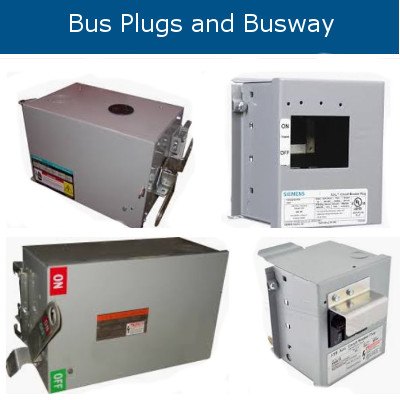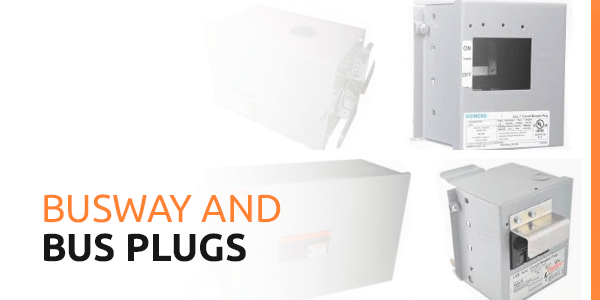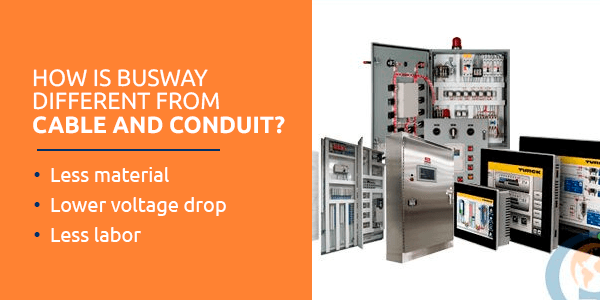Bussway and Bus Plugs
Every commercial and industrial facility requires power to operate. And every facility must have the infrastructure to distribute that power to the systems and pieces of equipment relying on it.
Busway and bus plugs offer an ideal solution. They are easy to install, and they provide a practical, effective way to deliver power throughout a facility, even if its layout consistently changes. The guide below will explain more about how these essential systems and components work.
-
 SIEMENS
SIEMENSSIEMENS US2:MBBX41000BC2B0 XQR-HD w/L6-15R , SURF MT, 22kA, BLACK
- Model #:
- MBBX41000BC2B0
- UPC #:
- 040892814026
- Part #:
- US2:MBBX41000BC2B0
- New/Surplus $ 109263
- Refurb. Price $76484 Save up to $ 32779
- Repair Price $54632 Save up to $ 54631
-
 SIEMENS
SIEMENSSIEMENS US2:MBBXA1000AN1B0 XPM3 w/5-15R , SURF MT, 10kA, BLACK
- Model #:
- MBBXA1000AN1B0
- UPC #:
- 040892814033
- Part #:
- US2:MBBXA1000AN1B0
- New/Surplus $ 109263
- Refurb. Price $76484 Save up to $ 32779
- Repair Price $54632 Save up to $ 54631
-
 SIEMENS
SIEMENSSIEMENS US2:MBBXA1000AN1G0 XQR-HD w/5-15R, SURF MT, 10kA, GRAY
- Model #:
- MBBXA1000AN1G0
- UPC #:
- 040892814040
- Part #:
- US2:MBBXA1000AN1G0
- New/Surplus $ 109263
- Refurb. Price $76484 Save up to $ 32779
- Repair Price $54632 Save up to $ 54631
-
 SIEMENS
SIEMENSSIEMENS US2:MBBXA1000AN2B0 XPM3 w/5-15R , SURF MT, 22kA, BLACK
- Model #:
- MBBXA1000AN2B0
- UPC #:
- 040892814057
- Part #:
- US2:MBBXA1000AN2B0
- New/Surplus $ 109263
- Refurb. Price $76484 Save up to $ 32779
- Repair Price $54632 Save up to $ 54631
-
 SIEMENS
SIEMENSSIEMENS US2:MBBXA1000BN1B0 XQR-HD w/5-15R, SURF MT, 10kA, BLACK
- Model #:
- MBBXA1000BN1B0
- UPC #:
- 040892814064
- Part #:
- US2:MBBXA1000BN1B0
- New/Surplus $ 109263
- Refurb. Price $76484 Save up to $ 32779
- Repair Price $54632 Save up to $ 54631
-
 SIEMENS
SIEMENSSIEMENS US2:MBBXA1000BN2B0 XPM3 w/5-15R , SURF MT, 22kA, BLACK
- Model #:
- MBBXA1000BN2B0
- UPC #:
- 040892814071
- Part #:
- US2:MBBXA1000BN2B0
- New/Surplus $ 109263
- Refurb. Price $76484 Save up to $ 32779
- Repair Price $54632 Save up to $ 54631

What Are Busway and Bus Plugs?
To know more about how these systems work, let’s start by examining what busway and bus plugs are.
What Is Busway?
Busway is infrastructure for an electrical distribution system. It connects to electrical equipment like transformers, panelboards and switchgear to deliver electricity. It consists of a protective enclosure that contains parallel bars known as bus bars. The enclosure also holds components such as fittings, straight lengths and accessories.
Some electrical systems use busway in place of conduits and cables. A busway electrical distribution system is sometimes a better choice than cable and conduit systems for several reasons. Below are some of busway’s advantages:
- – Simpler to configure: Busway is easy to connect to extend electrical power. A facility might distribute electricity to far-flung areas by attaching more standard lengths of busway.
- – Less costly to install: Busway contains fewer attachable and detachable components, so it requires less time and effort to put in.
- – Easier to replace: Similarly, busway’s straightforward construction makes it easier to replace at the end of its life span.
And below are a few of the components a busway electrical system typically contains:
- – Bus bars: The parallel bus bars, also known as conductors, conduct electricity. They come in different sizes and usually contain highly conductive copper or aluminum.
- – Housing: The housing forms a protective casing around the bus bars. It is usually made from sturdy steel or aluminum.
- – Fittings: The fittings route busway from one electrical termination or connection to the next. They include components like elbows, tees and offsets.
- – Insulation system: Busway requires an insulating system to separate the bus bars from one another. The insulation often includes a mixture of epoxy, mylar and air and is essential for preventing short circuits and other electrical faults.
What Are Bus Plugs?
Bus plugs are large, industrial electric plugs that connect to the busway. They distribute electrical power from the main busway to specific areas, often powering particular lighting systems or pieces of equipment. On a factory floor, for instance, where equipment layout must promote efficiency by maximizing available space, equipment might be far from the wall, and a bus plug helps it reach an electrical power source.
The main benefit of bus plugs is the flexibility they afford. They are not permanently hard-wired into the building, so a facility can detach and reattach them in different configurations to accommodate new layouts or floor plans or new equipment that needs to come online.
Uses for Busway and Bus Plugs
Businesses often use busway for electrical distribution in situations where cables and conduits are inadequate. Data centers, industrial facilities, mission-critical facilities, petrochemical plants and power plants all frequently use busway and bus plugs to deliver electrical power to essential equipment.
Because of its flexibility, busway is ideal in applications in which load locations will likely fluctuate. For instance, in a hospital, electrical demands may change as health care workers move various pieces of medical equipment. Or in a high-rise apartment complex, different units may see varying electrical loads. Where load locations may alter, busways become even simpler, less costly and easier to replace than their counterparts.
Common Questions and Problems for Busway and Bus Plugs
Below are a few frequently asked questions about busway and bus plugs.

How Is Busway Different From Cable and Conduit?
Cable and conduit and busway systems both perform the same primary function – distributing power between pieces of electrical equipment. And some systems use a combination of cable and conduit. The two have some substantial differences, however:
- – Less material: Busway uses less material than cable and conduit. Manufacturers often engineer each piece of busway for a specific job, so they can eliminate excess by providing only the structures needed.
- – Lower voltage drop: Busway’s solid-phase bars allow for lower impedance than is possible with cable and conduit. The lower impedance results in a lower voltage drop.
- – Less labor: The many pieces of cable and conduit systems are highly labor-intensive to install, especially if the system has a high ampere rating. Busway comes in fewer parts and is comparatively easy to install.
What Are Some Different Types of Busway?
Busway comes in a few different forms, including the following:
- – Air-insulated busway: Air-insulated busway generally has copper or aluminum bars with plastic clips to keep them spread apart so air can provide insulation.
- – Nonsegregated busway: Nonsegregated busway usually has copper bars in a single enclosure, separated with air and epoxy insulation.
- – Sandwich-type busway: Sandwich-type busway typically contains bars stacked together inside a nonventilated housing.
- – Track busway: Track busway provides an extensive plug-in layout so the facility can attach bus plugs just about anywhere along the system’s length.
What Are Some Common Busway Failures?
Facilities may see various busway problems over time, especially if they neglect routine maintenance. Cable and conduit systems require little upkeep once installed, but busway requires regular maintenance for proper performance. Issues that could occur include:
- – Liquid infiltration: Unlike cable and conduit systems, busway contains exposed, energized, uninsulated conductors that liquid contaminants can interfere with. Liquid breaches are particularly problematic in vertical busway installations — the type found in high-rises — because the liquid contaminants can quickly flow down to many floors and ruin huge swaths of busway. Regular maintenance can detect and assess small amounts of damage from spills or leaks before they grow into a larger problem.
- – Insufficient protective structures: Inadequate circuit protection leads to overloads and power losses in busway. Additionally, the National Electrical Code (NEC) specifies that busway should have a 4-foot protective curb to prevent water on the floor from seeping into busway.
- – Ground faults: Arcing ground faults also sometimes occur because of inadequate maintenance. They can melt the busway or cause fires that destroy equipment and leave companies with thousands of dollars in losses.
- – Brand mismatches: Generally, facilities should use bus plugs with busway of the same brand. Mixing brands can sometimes result in incompatibilities and power losses.
Benefits of Buying Busway and Bus Plugs From Global Electronic Services
When your company purchases busway and bus plugs from us, you can choose between dependable options to find the distribution components that best fit your electrical needs. We carry a tremendous range of Siemens products and other brands to give you a broad selection.
Contact Global Electronic Services for Your Busway and Bus Plug Needs
Browse the options on this page to find out more about our extensive catalog of busway and bus plugs. Then, contact us today to purchase these products or learn more.

